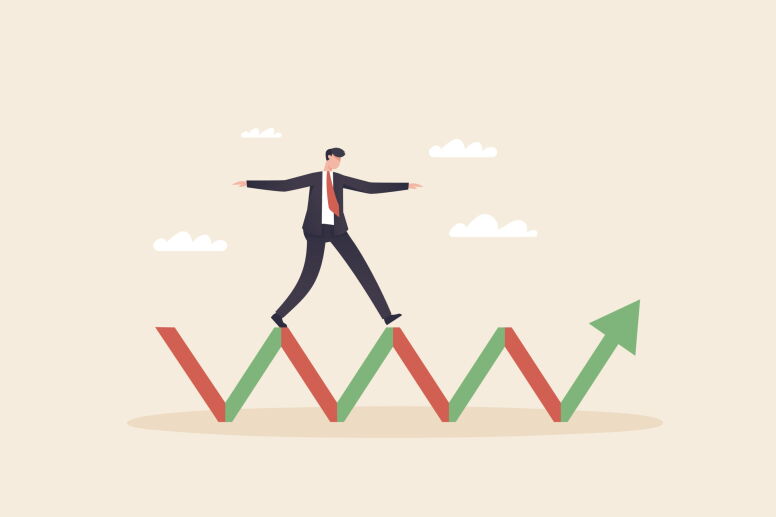News & Stories
Uncertainty: Why it’s not always bad news for financial markets

Professor Gill Segal is reshaping how we understand uncertainty in financial markets. Through his research, he challenges the conventional wisdom that uncertainty is inherently negative.
His findings reveal that not all uncertainty is created equal – some types can drive innovation, investment and long-term economic growth.
“Traditionally, people treated uncertainty as if it were just one thing,” Segal says.
“When you look at aggregate uncertainty or volatility, the effect you get on equity markets or economic growth is almost always negative.”
“And that led to the traditional notion that uncertainty is typically bad. It’s associated with lower valuations, reduced investment and slower economic growth.”
Yet Segal’s research paints a more nuanced picture. Segal introduces an important distinction: “good” versus “bad” uncertainty. By dissecting total uncertainty into its different “flavors,” he demonstrates that some types – what he calls “good uncertainties” – can boost valuations, predict higher consumption and even stimulate GDP growth.
“There are many ways to dissect total uncertainty into different types,” he says. “And when you do that, you often see that one type is surprisingly good – when it goes up, production and output also go up. The same thing happens in equity markets.”

Professor Gill Segal
So how can investors and policymakers isolate good uncertainties? One way, Segal says, is based on pure statistics. The technical term is “semivariances.” In simple terms, it’s a technique that tells you whether uncertainty dominates the positive side of future growth’s distribution, making it good, or the negative side, making it bad.
“An example of such good uncertainty – meaning an uncertainty that was concentrated on the positive side of growth’s prospects – is the IT revolution of the 1990s,” Segal says. “When people saw that initial technology, they knew it was going to change the world for the better. But how good was the technology actually going to be? That is still uncertainty, but it focuses on the upside of economic growth’s trajectory.”
Segal also highlights the introduction of generative artificial intelligence as another instance of good uncertainty. “We don’t know how to use that technology fully yet, but the uncertainty is not necessarily a bad thing,” he says.
“In fact, it’s encouraging people to invest more in research and development. They won’t shy away from expanding economic activity. It also contributes to the high valuations of tech companies we see right now in the markets.”
But there is another measure from Segal’s research that tells you if uncertainty is going to have a good or a negative effect: time horizon. Short-term uncertainty often depresses activity, but long-term uncertainty can fuel optimism and investment.
“Uncertainty about the short-run is bad because it increases the chance of making a wrong decision, and once you realize you made a mistake, there isn’t much flexibility to correct your action,” Segal says.
“But with uncertainty about the long-term, you think about the upside of your investment projects. If things go south, you’ll have a chance to abandon the project. The longer the horizon, the more willing you are as a CEO to see uncertainty as an opportunity.”
For corporate managers, Segal’s research offers actionable guidance to understand if the nature of uncertainty they currently face is mostly over the short or the long run –whether it’s driven by the firm’s customers (downstream uncertainty) or its suppliers (upstream uncertainty).
Segal’s findings reveal that not all uncertainty is created equal – some types can drive innovation, investment and long-term economic growth.
“Customer-based uncertainty, which we also call downstream uncertainty, tends to have long-term impacts, whereas supplier-based uncertainty affects mostly the short run,” Segal says.
“As a corporate manager, I can just look at the stock return volatility of my customer firms over the last year and compare that to the stock return volatility of my supplier firms.”
“If the first one is higher, it’s a good time to invest as a company. It tells me that uncertainty is mostly about long-term perspectives, and I should see it as an opportunity.”
This insight has important implications for policymakers, especially in navigating economic shocks, like coronavirus pandemic.
“COVID had a high level of uncertainty, but we knew it was different to begin with,” Segal says. “Unlike other recessions that were dominated by higher upstream uncertainty, the rise in uncertainty during COVID was driven by higher downstream uncertainty from firms that are closest to final consumers. In other words, the good type of macroeconomic uncertainty went up.
“Seeing this in real time, you might expect a very short recession, and that economic conditions will improve sooner than later. For policymakers, that could have meant raising interest rates earlier, potentially mitigating inflationary pressures.”
Segal’s findings also underscore the importance of dissecting uncertainty for investors.
“Say that you see that the volatility index (VIX) is higher. When this happens, many investors shy away from equities.”
“I’d say that instead, it’s important to dissect the VIX into parts. You need to check if the elevated VIX is caused by customer firms or supplier firms. This can provide a clearer indication of whether it’s a good or bad time to invest. An increase in the volatility of customer firms predicts higher equity valuations up to two years ahead. It’s a good investment opportunity.”
Segal is ultimately changing how we view uncertainty – not as a monolithic threat but as a complex force with both risks and rewards.
His research insights remind us that uncertainty, when properly understood, can serve as a catalyst for innovation, growth and resilience.
“I wanted to show that uncertainty isn’t inherently negative,” Segal says. “Good uncertainty can drive investment, technological breakthroughs and long-term economic expansion. You just need to know where to look for it.”
Read more about Segal’s research here.